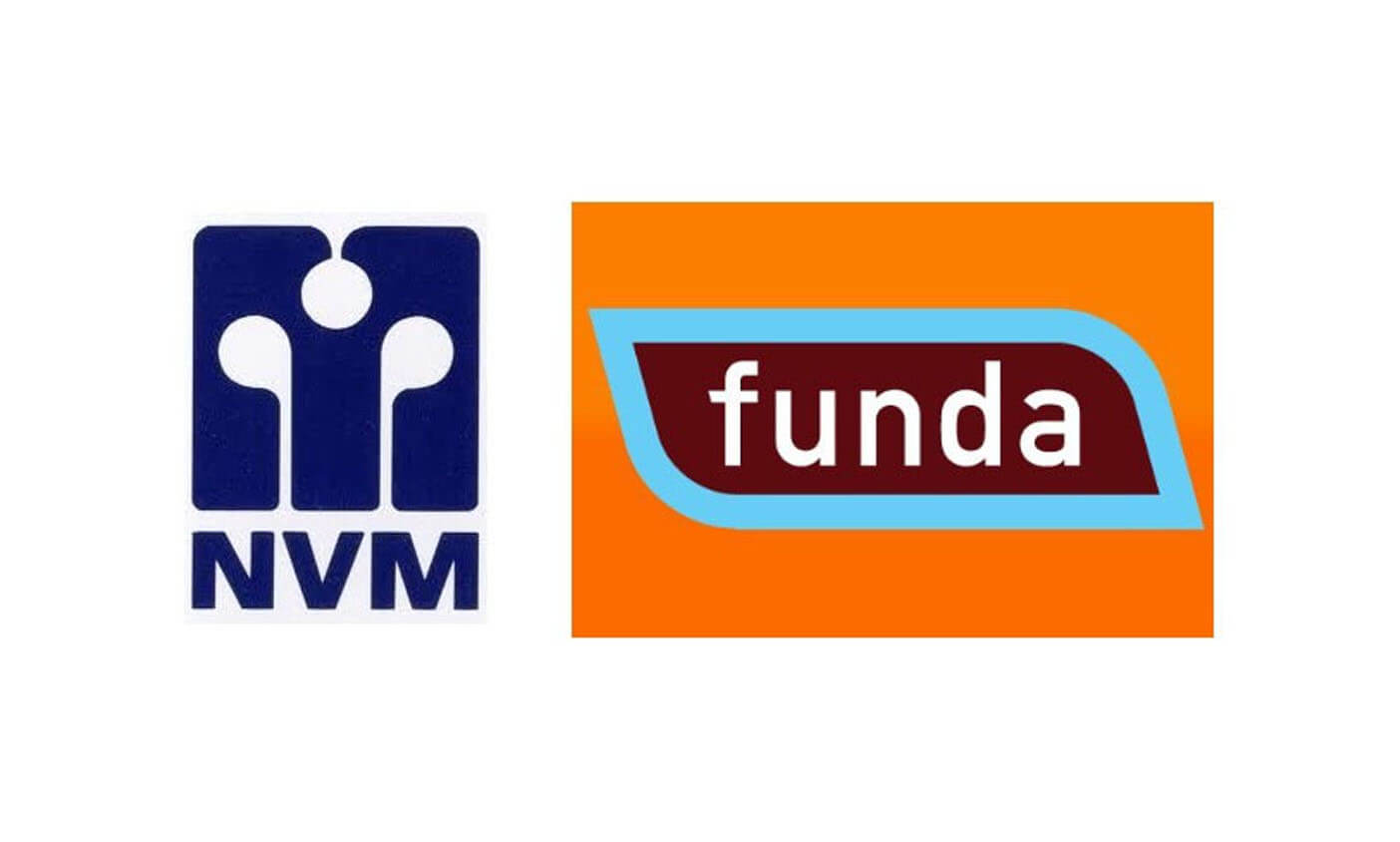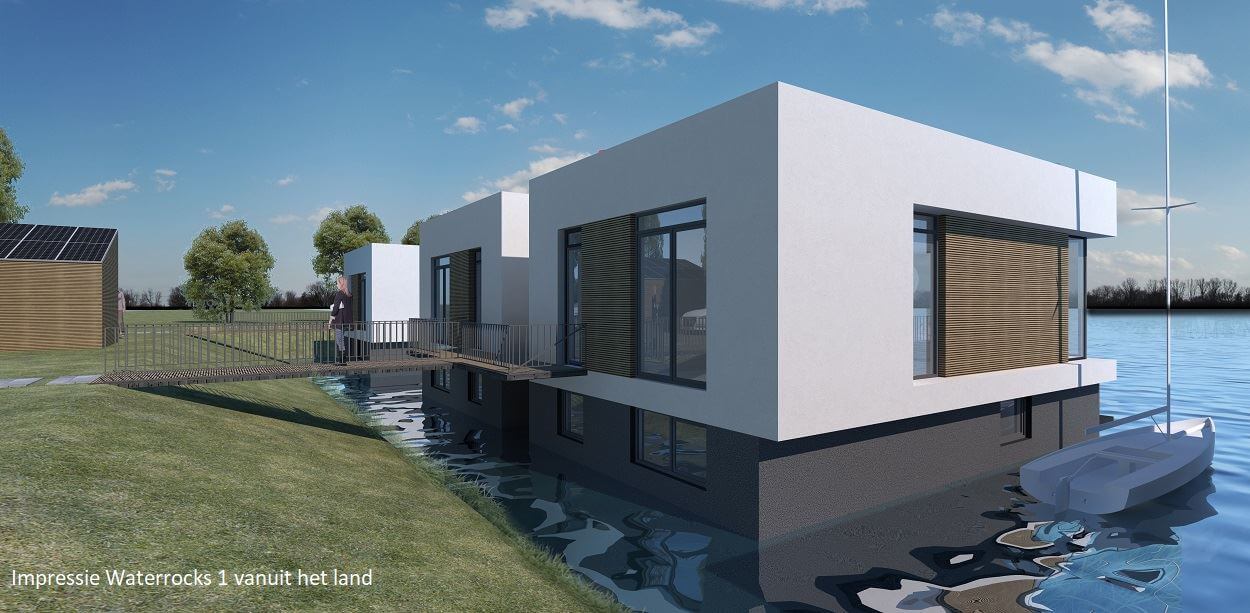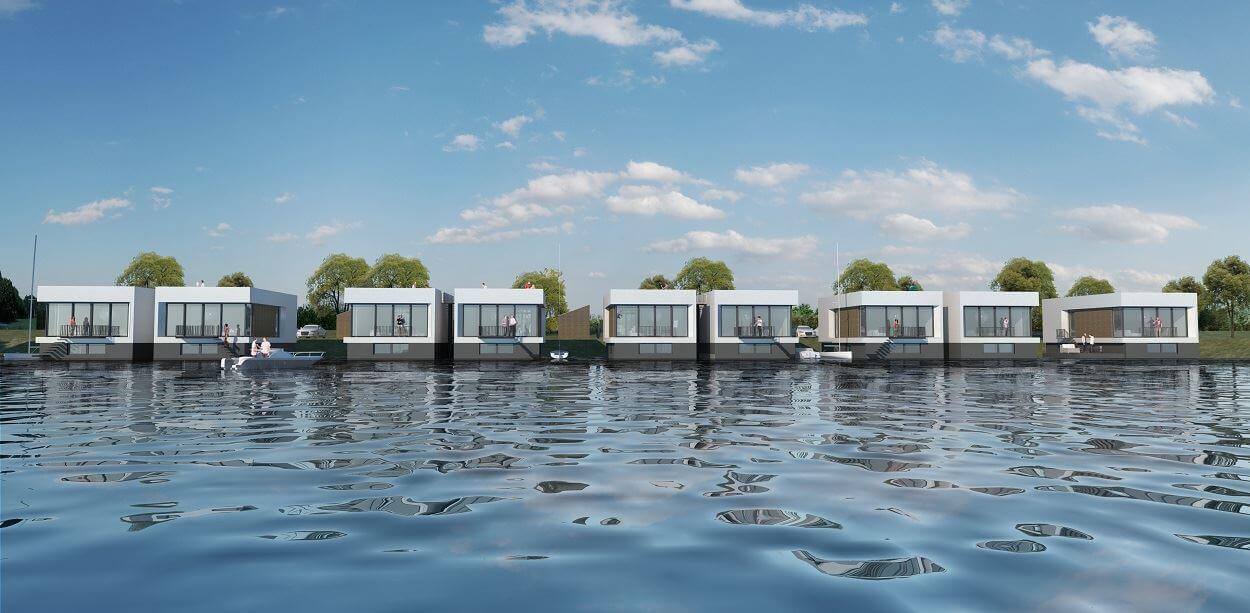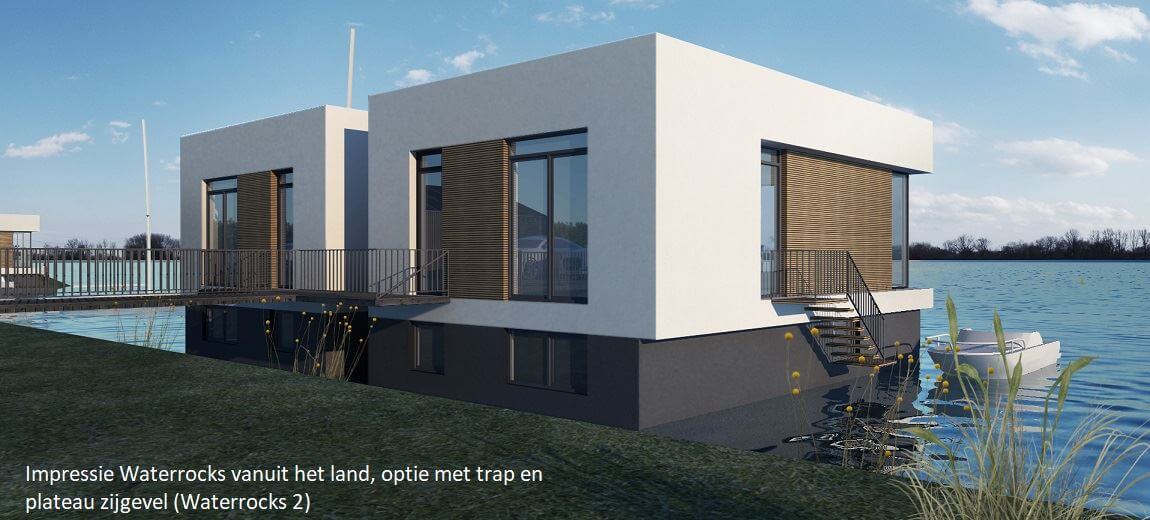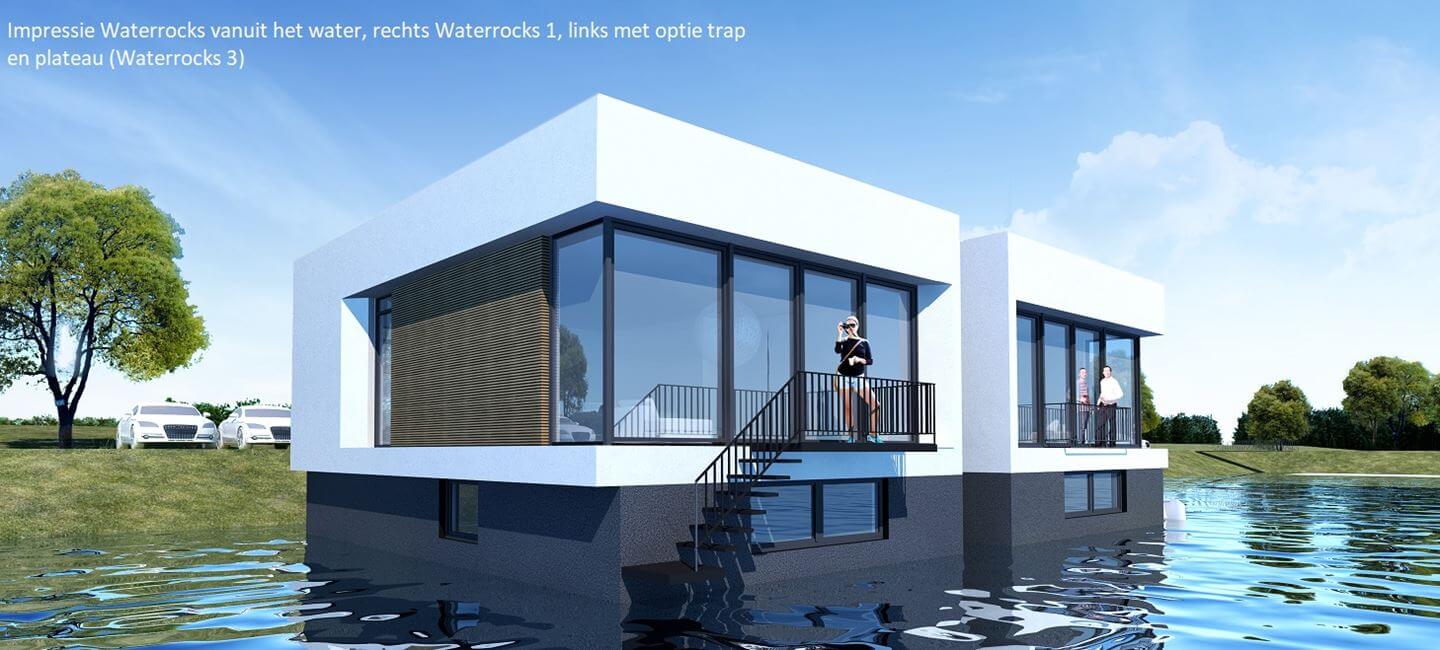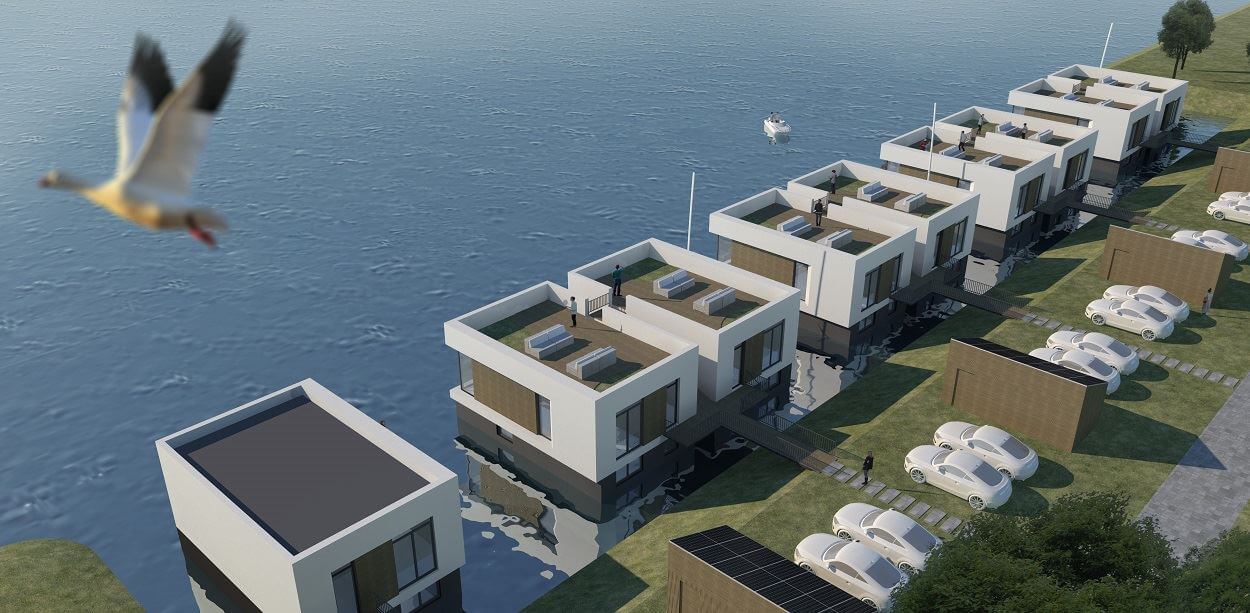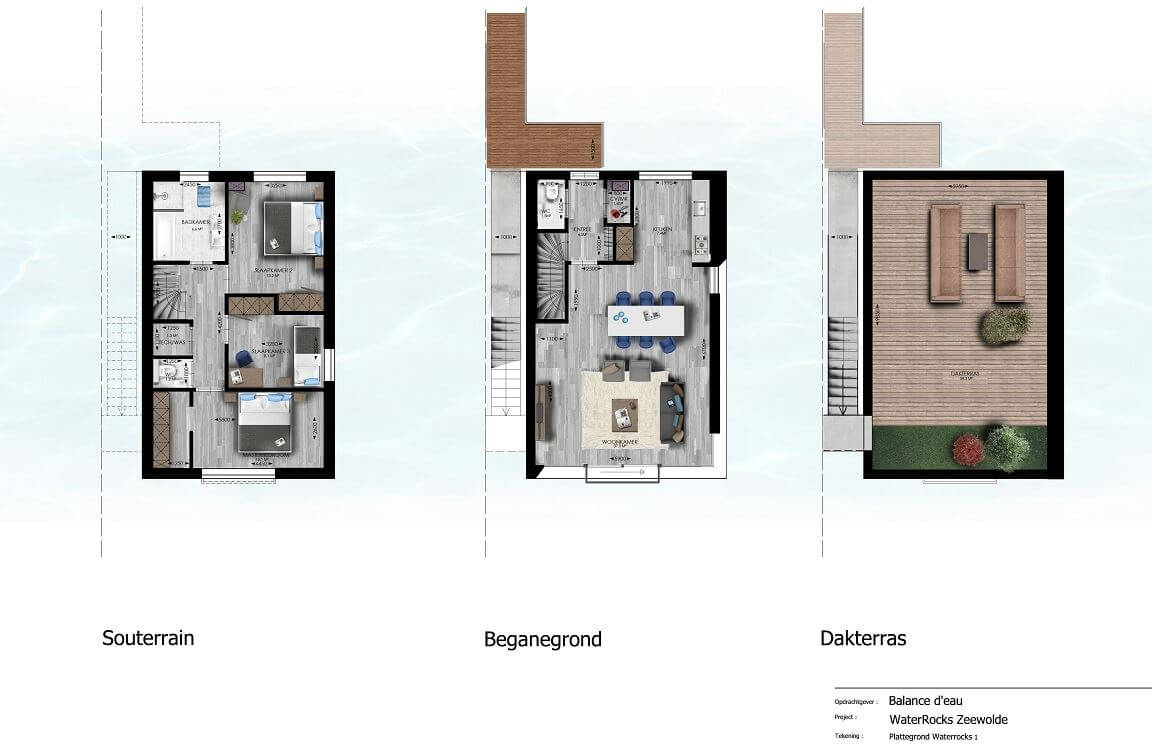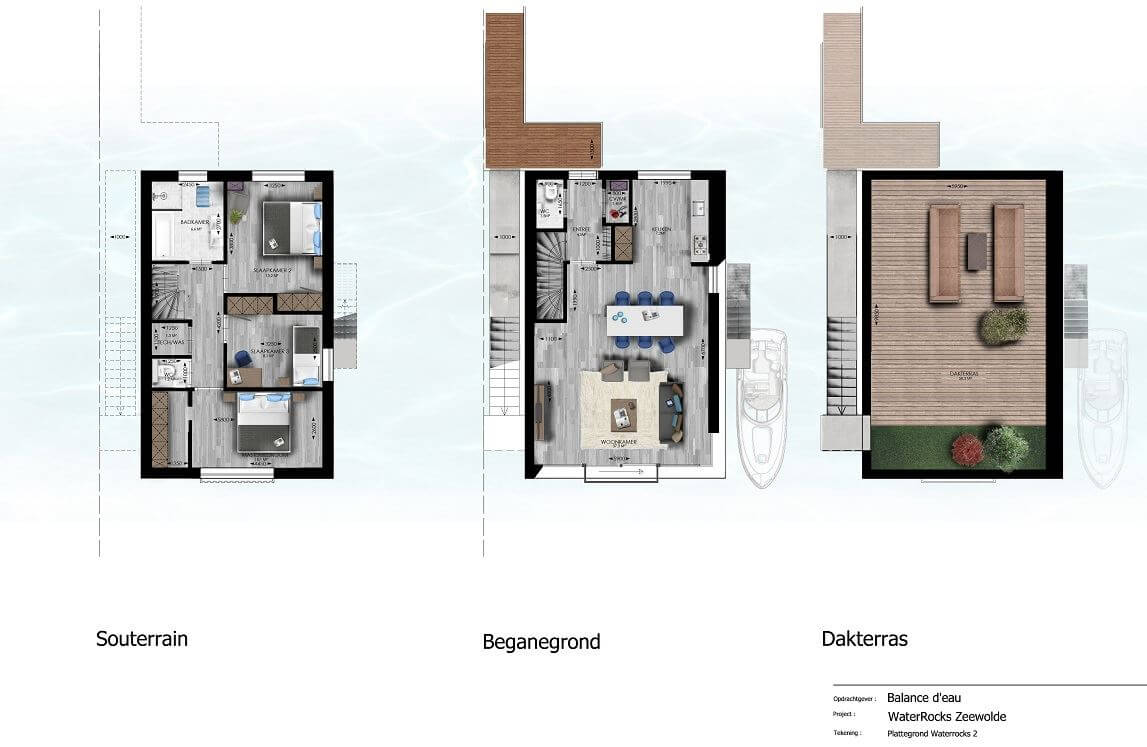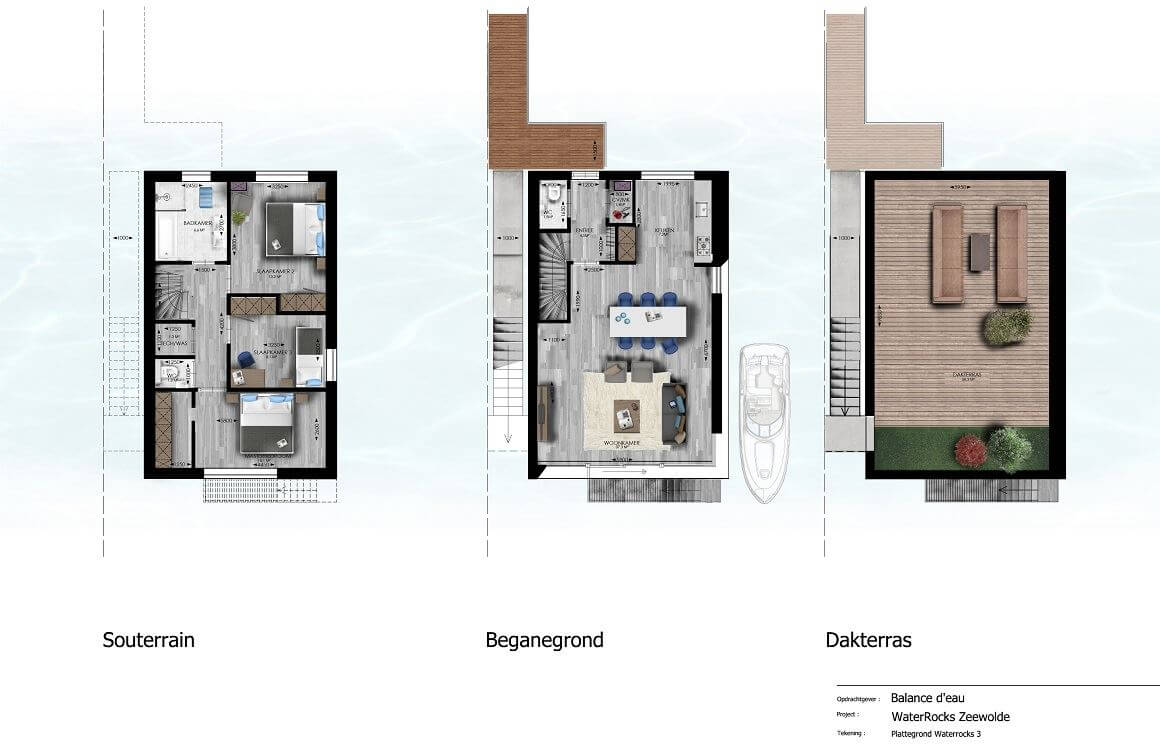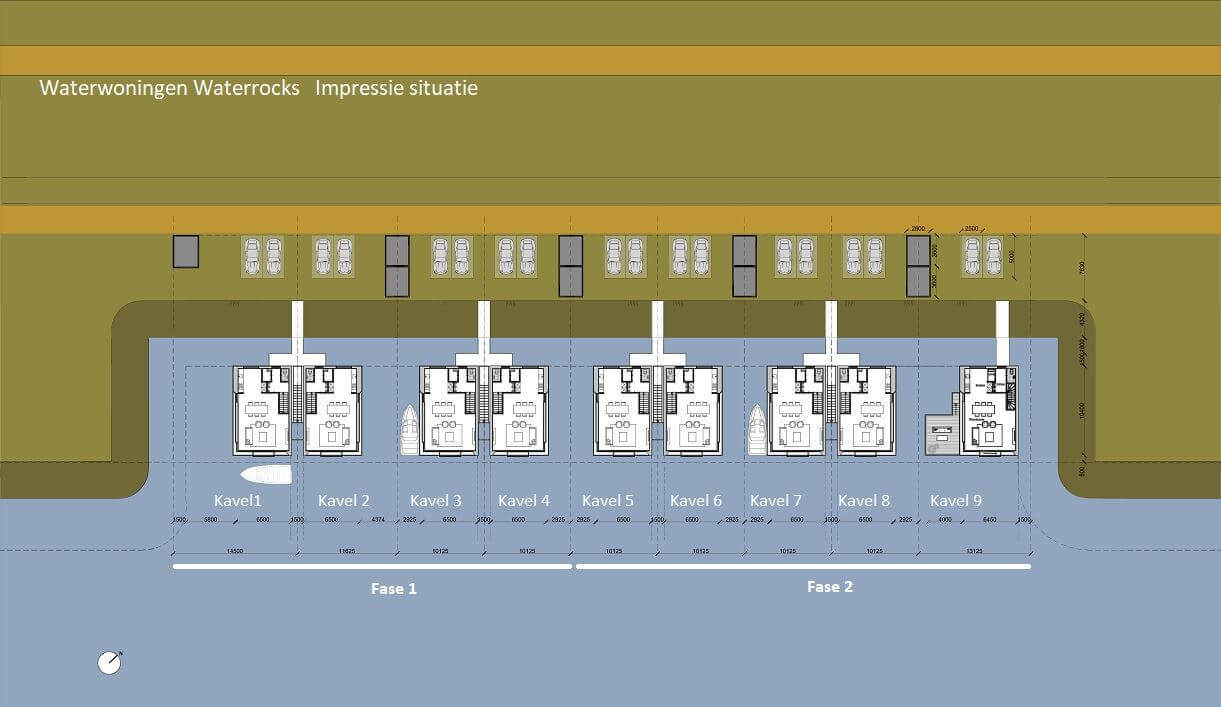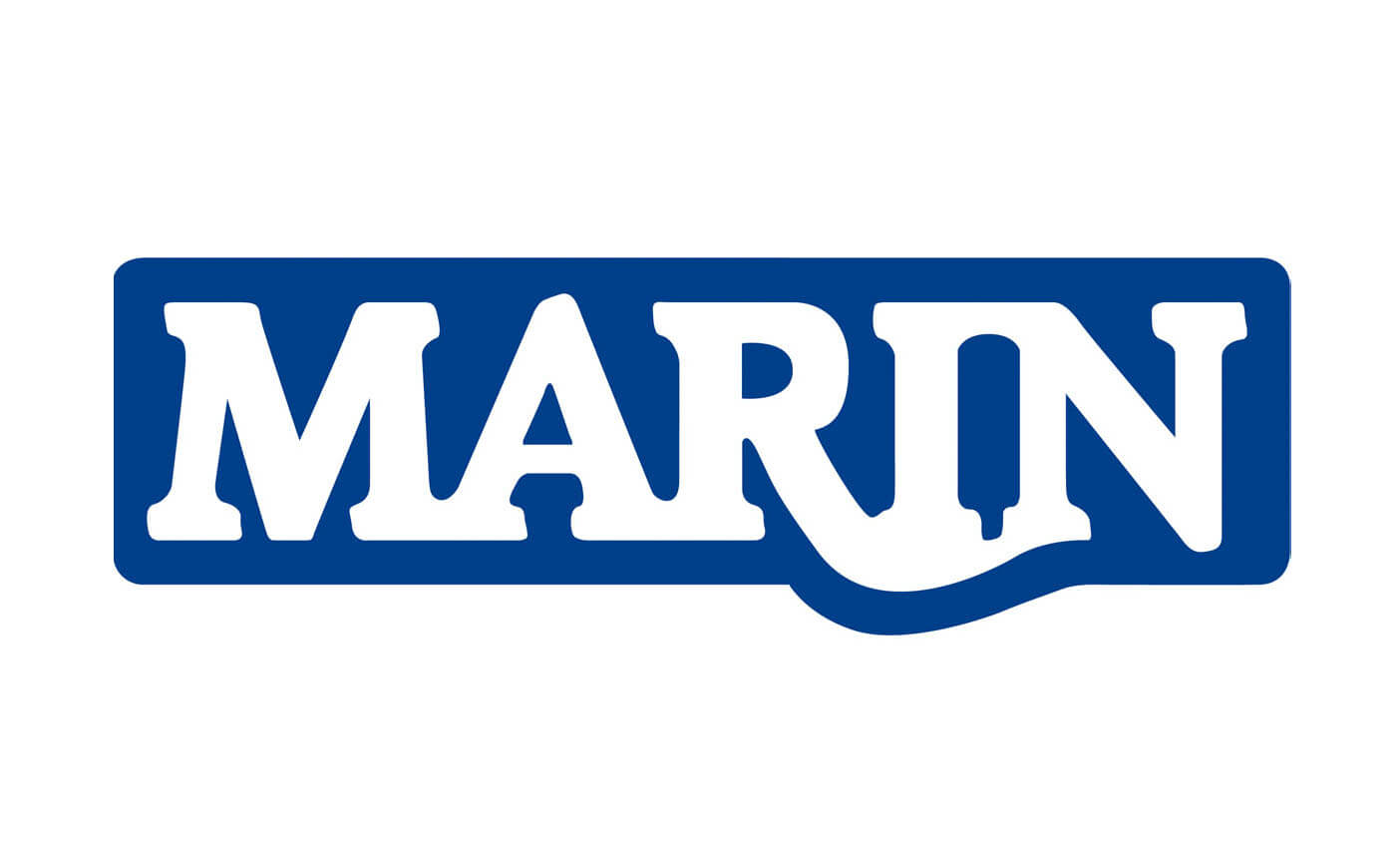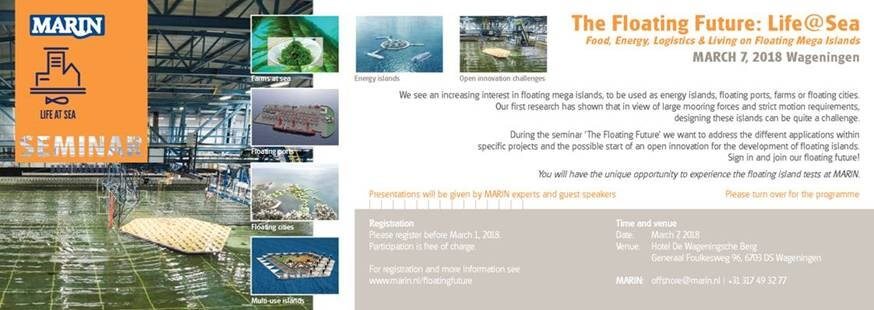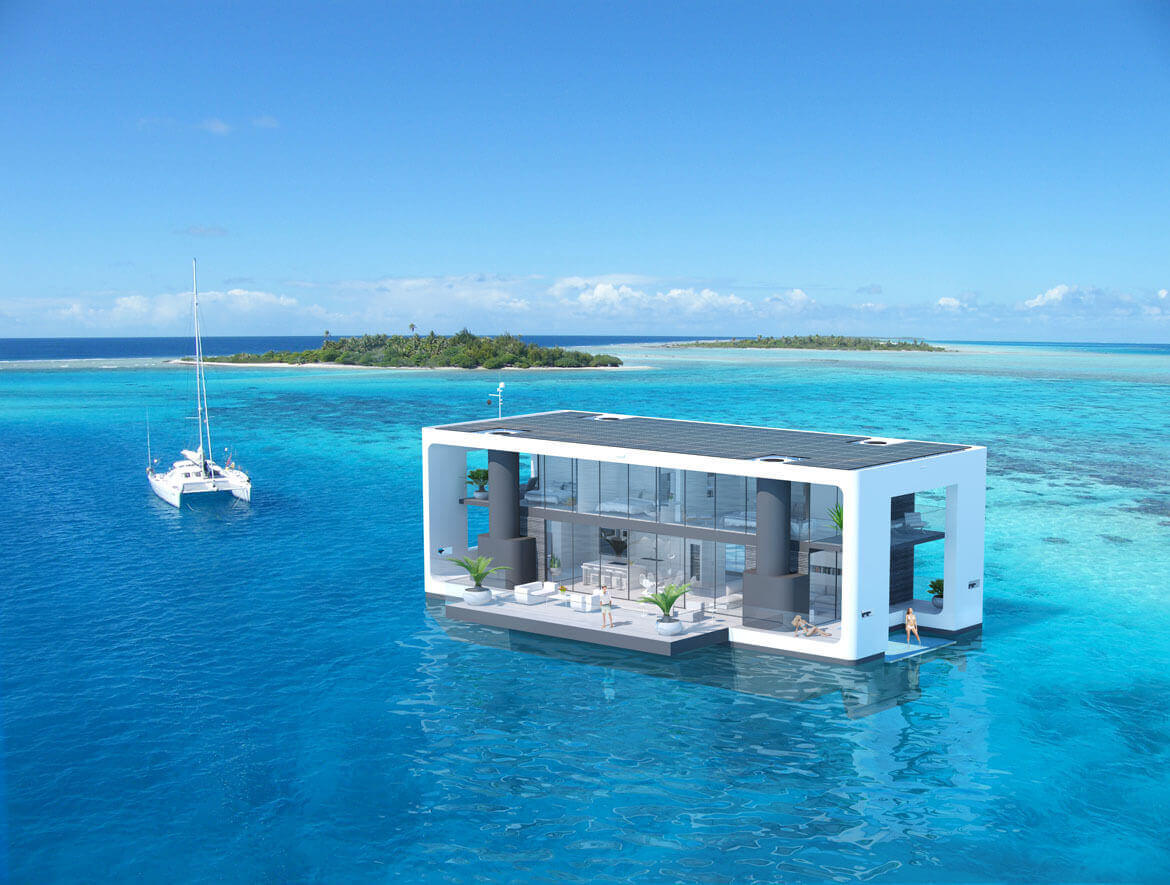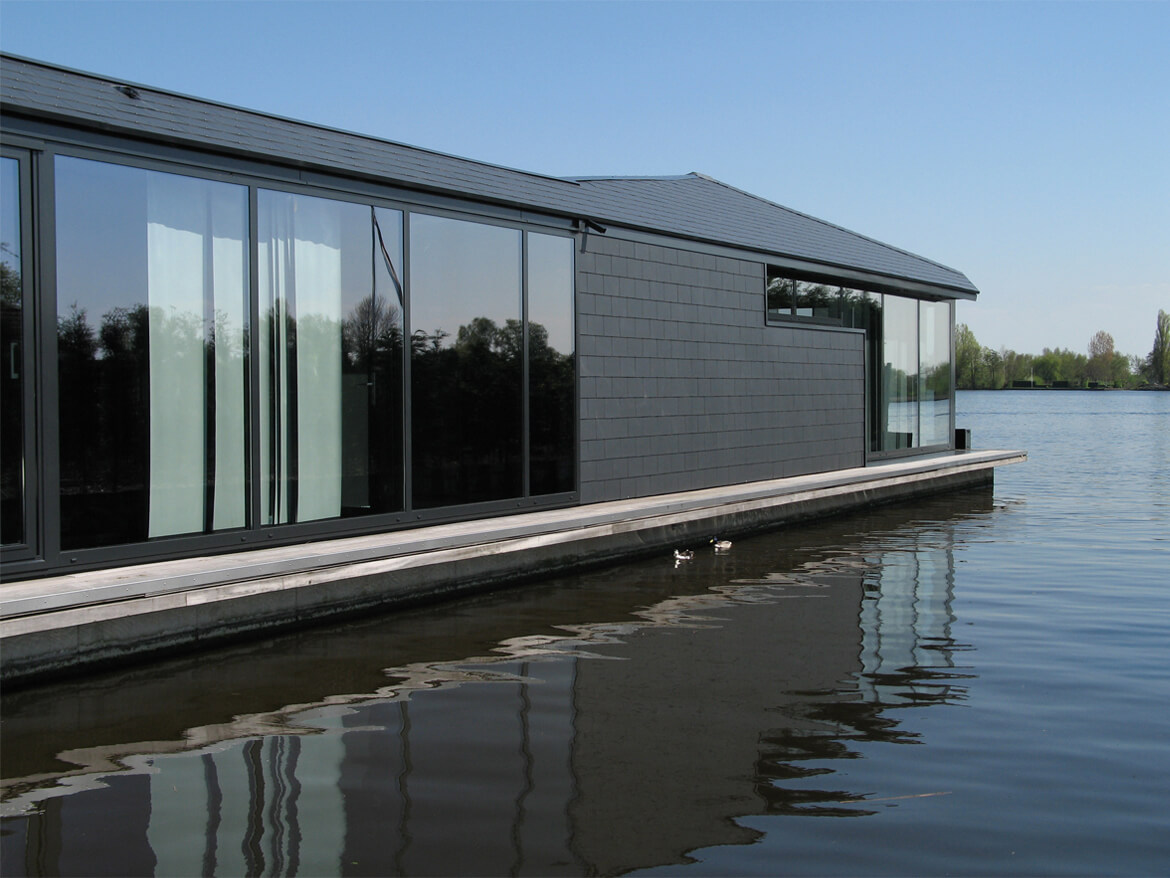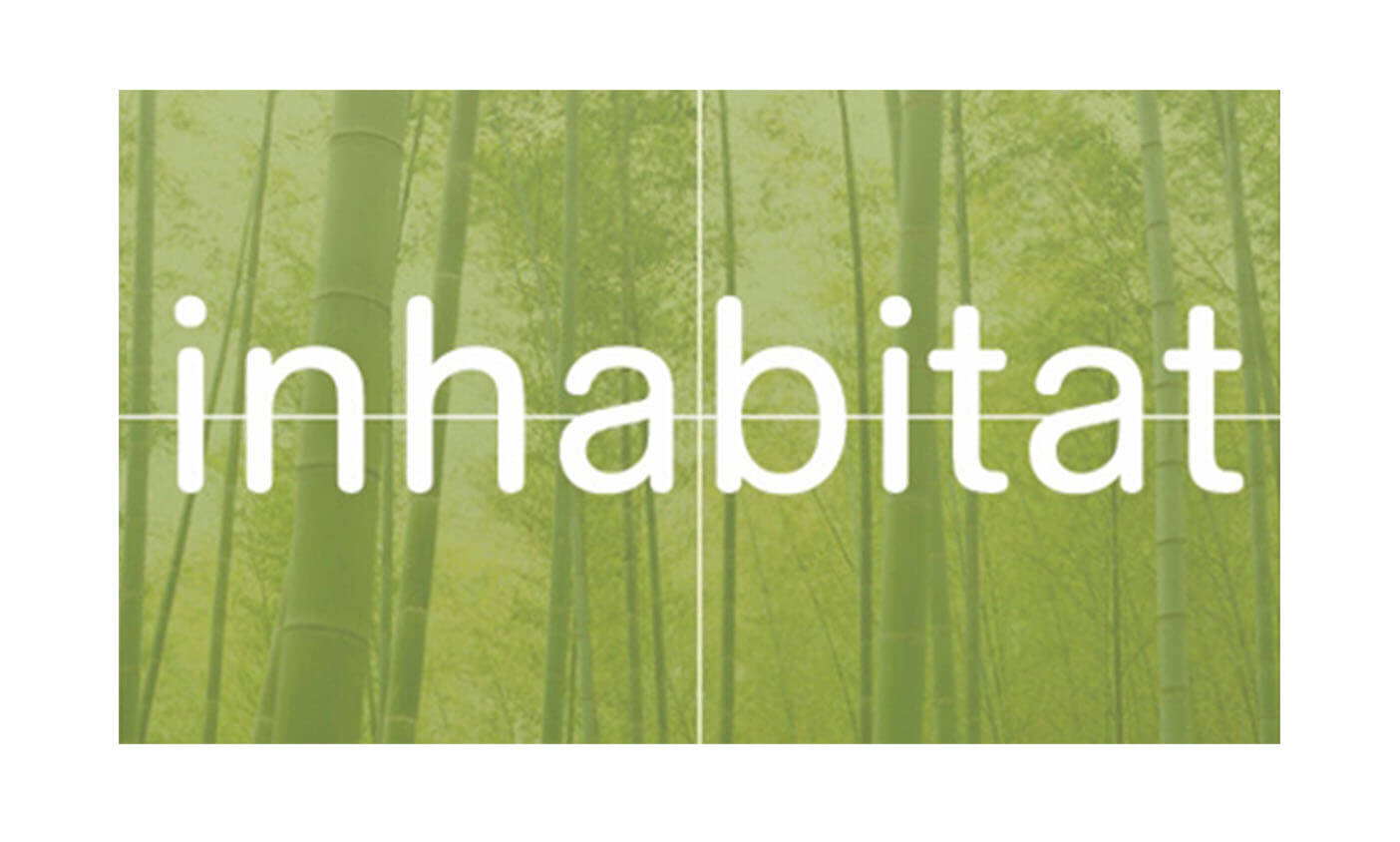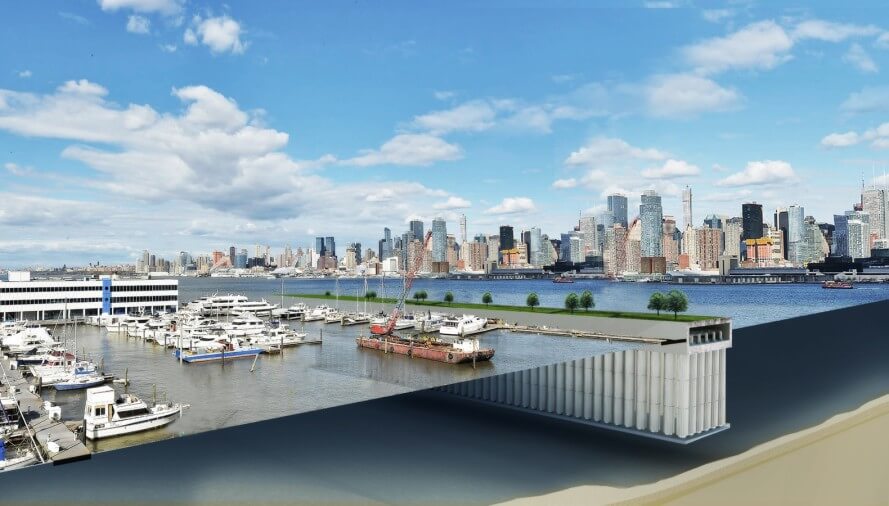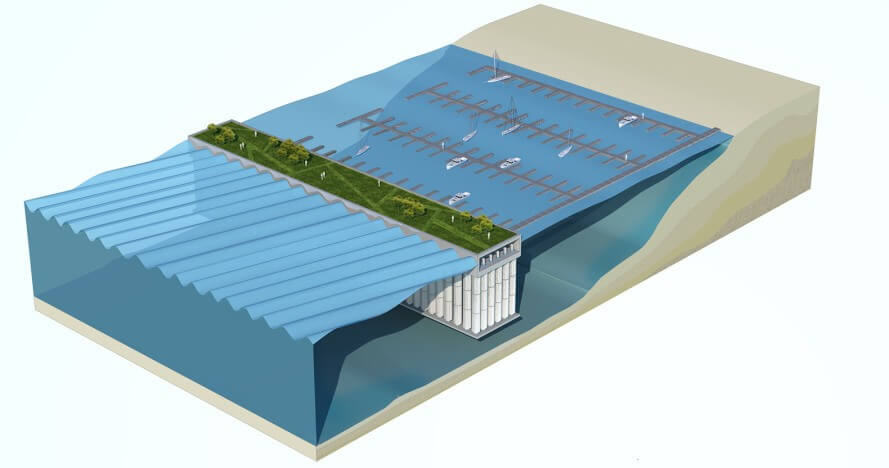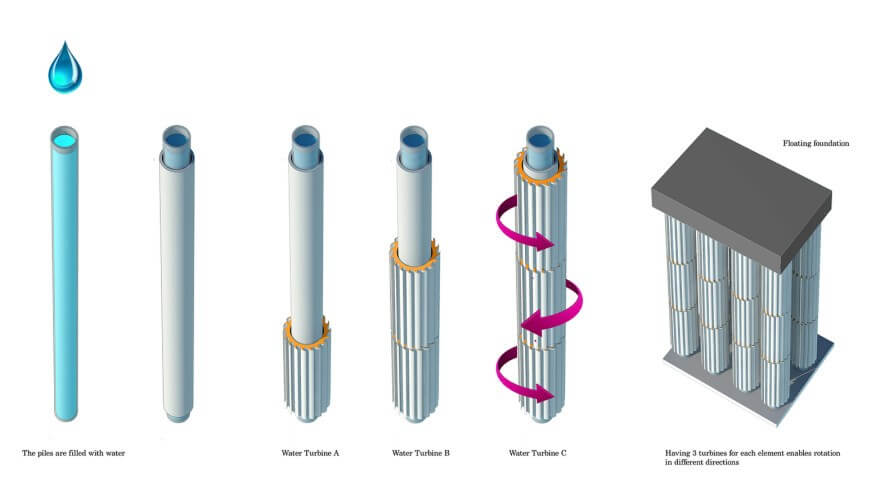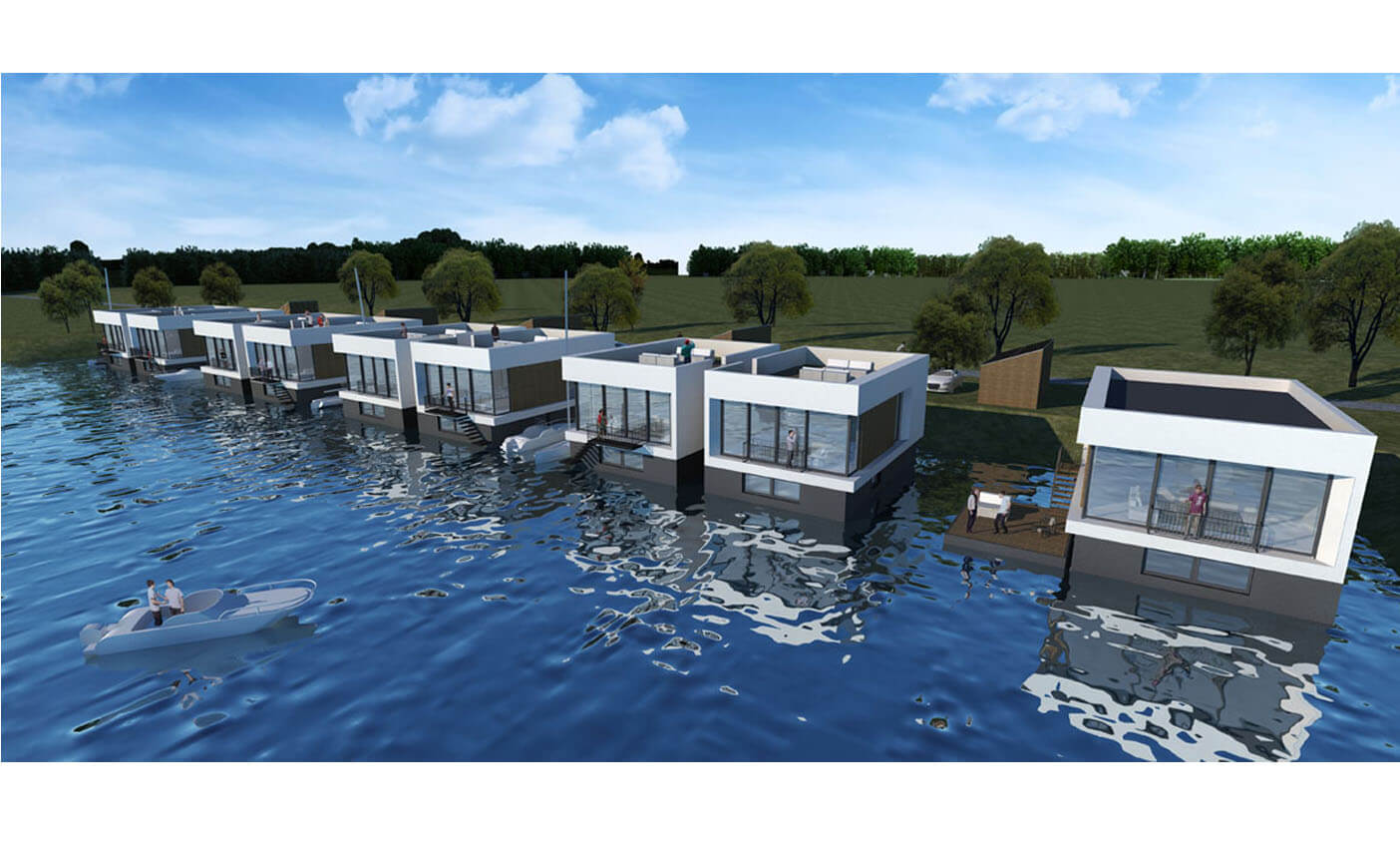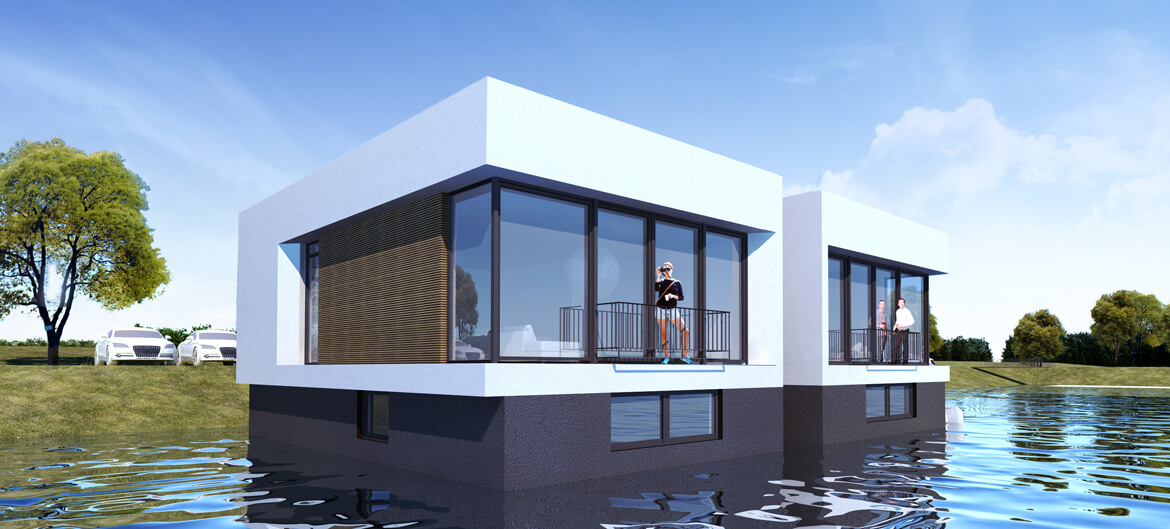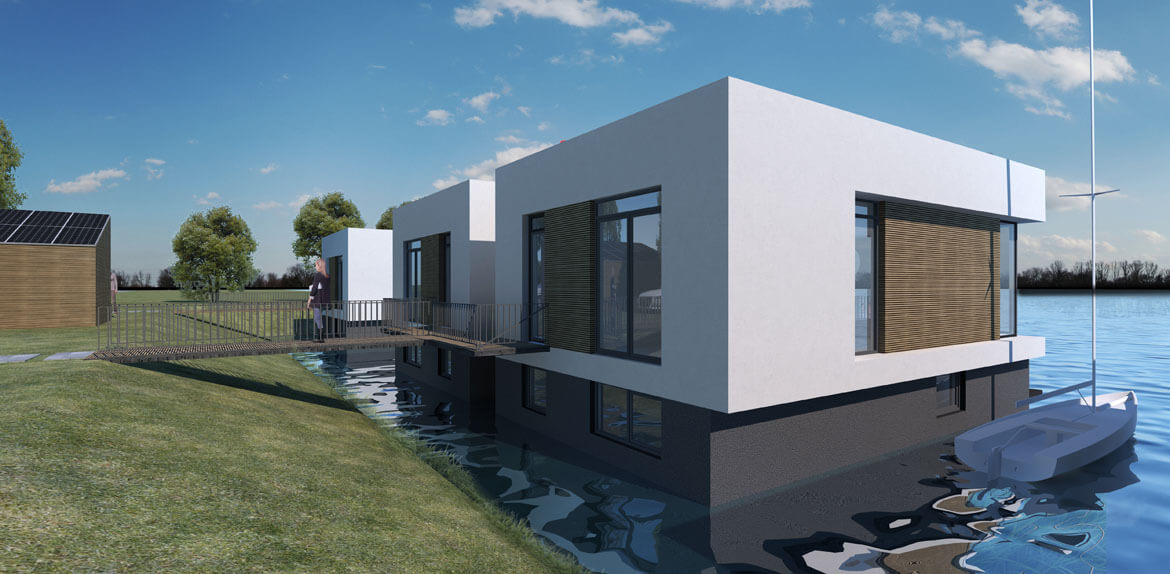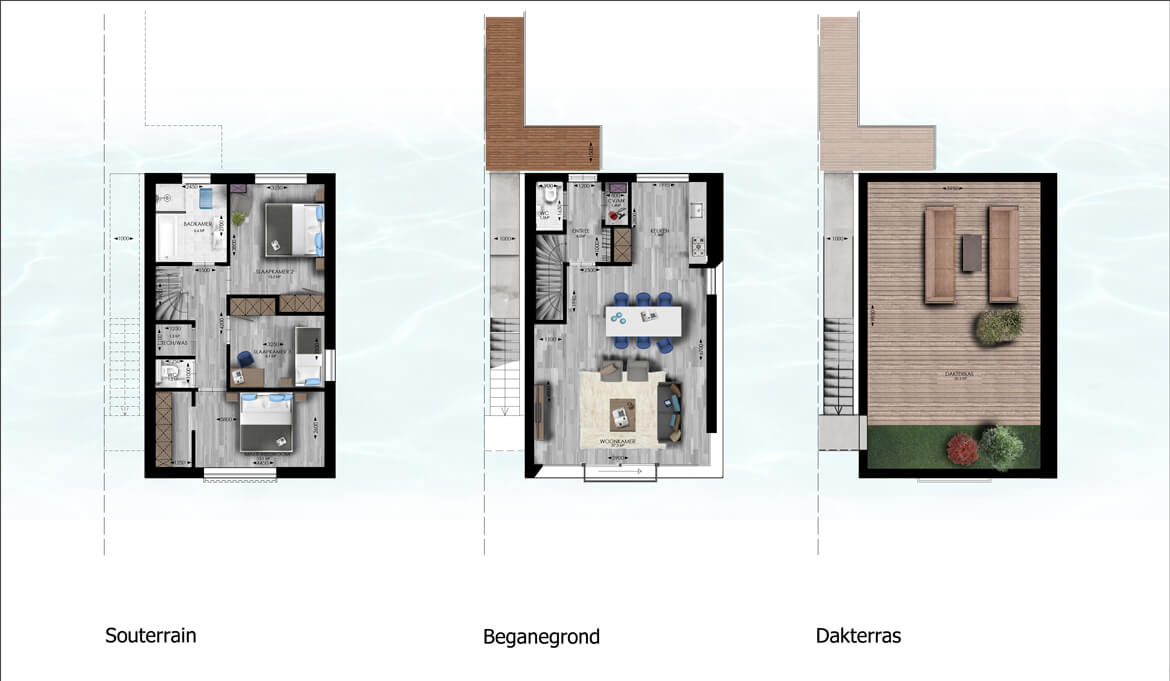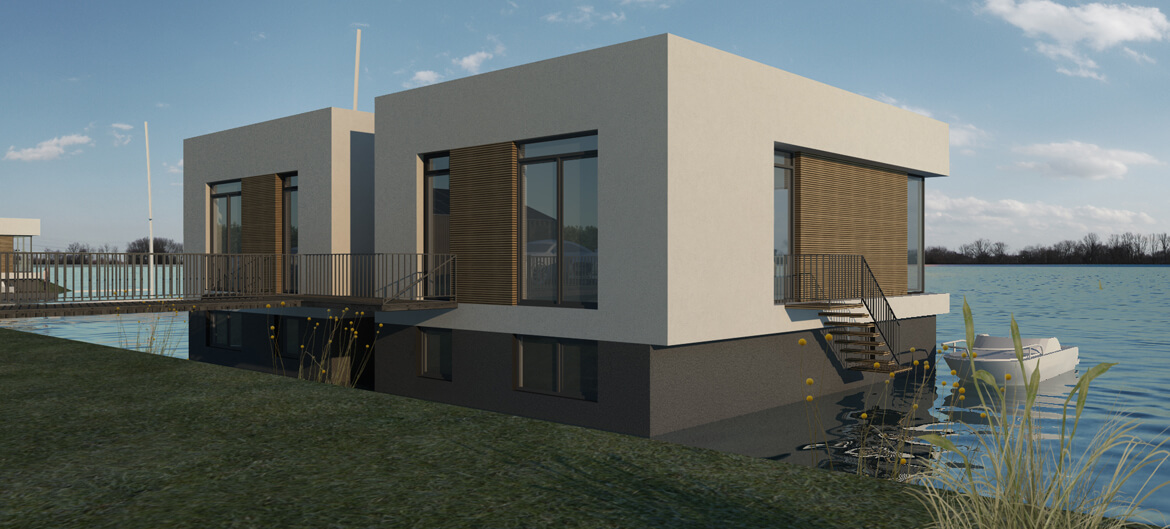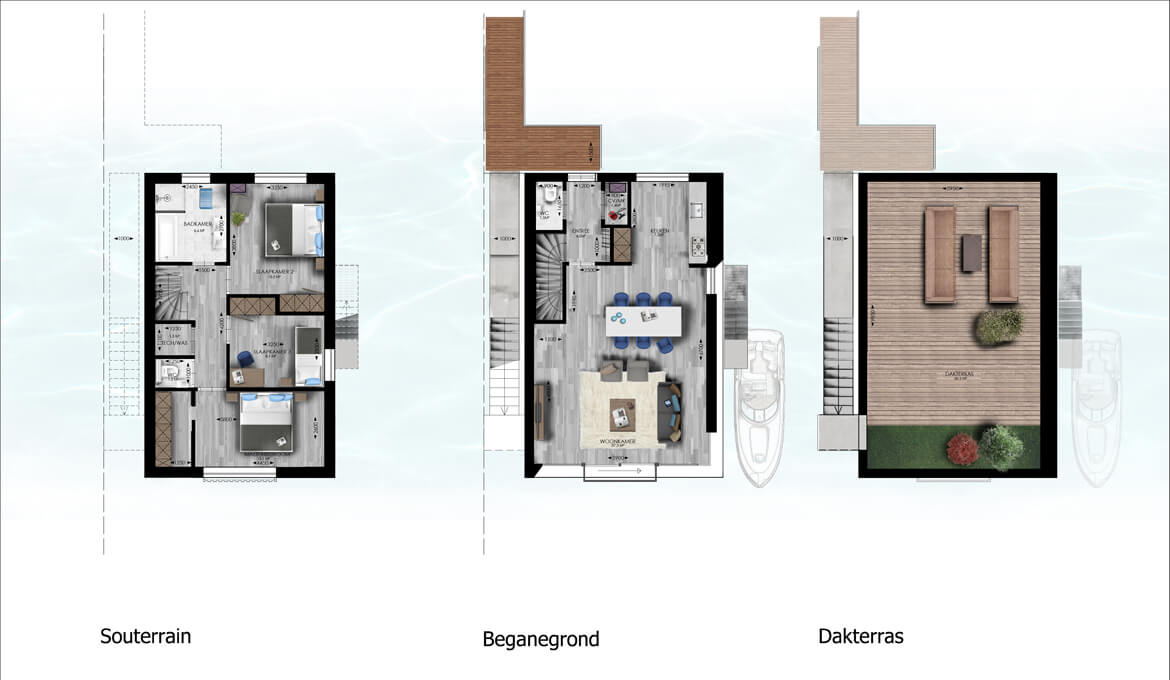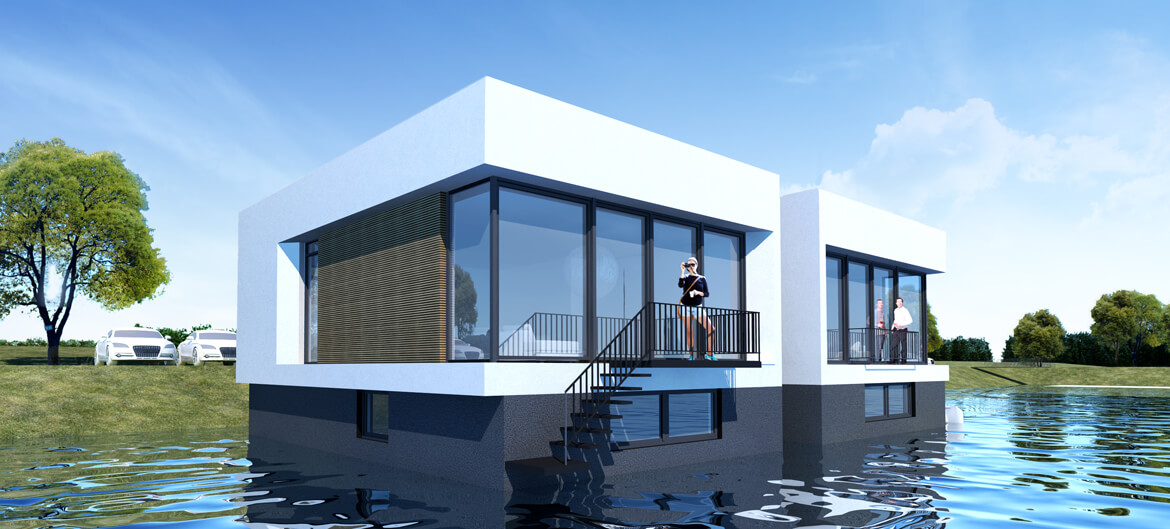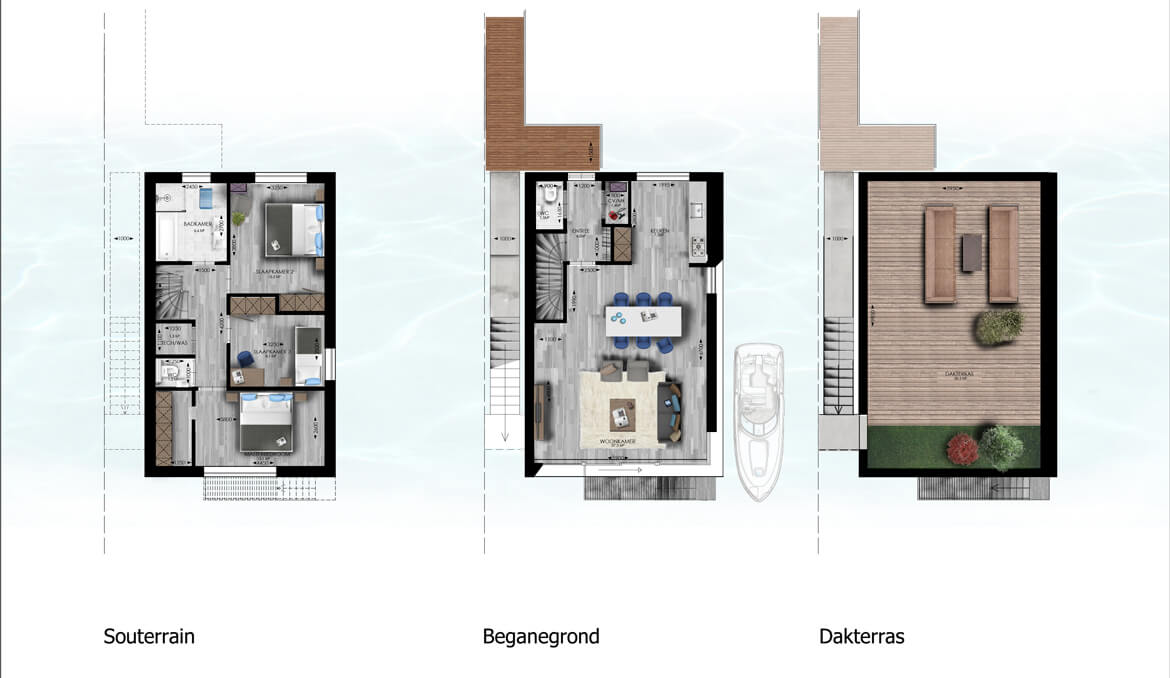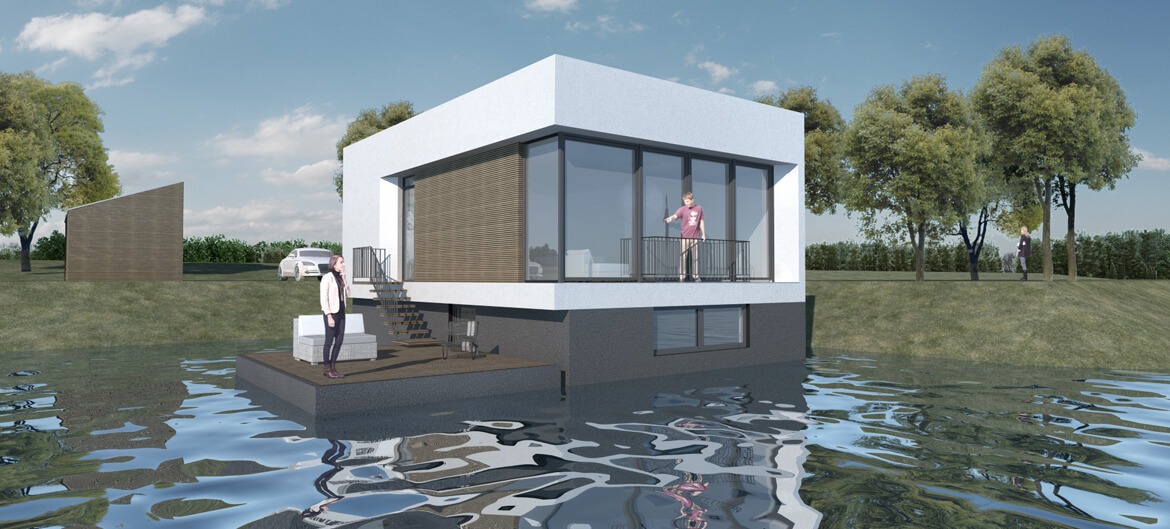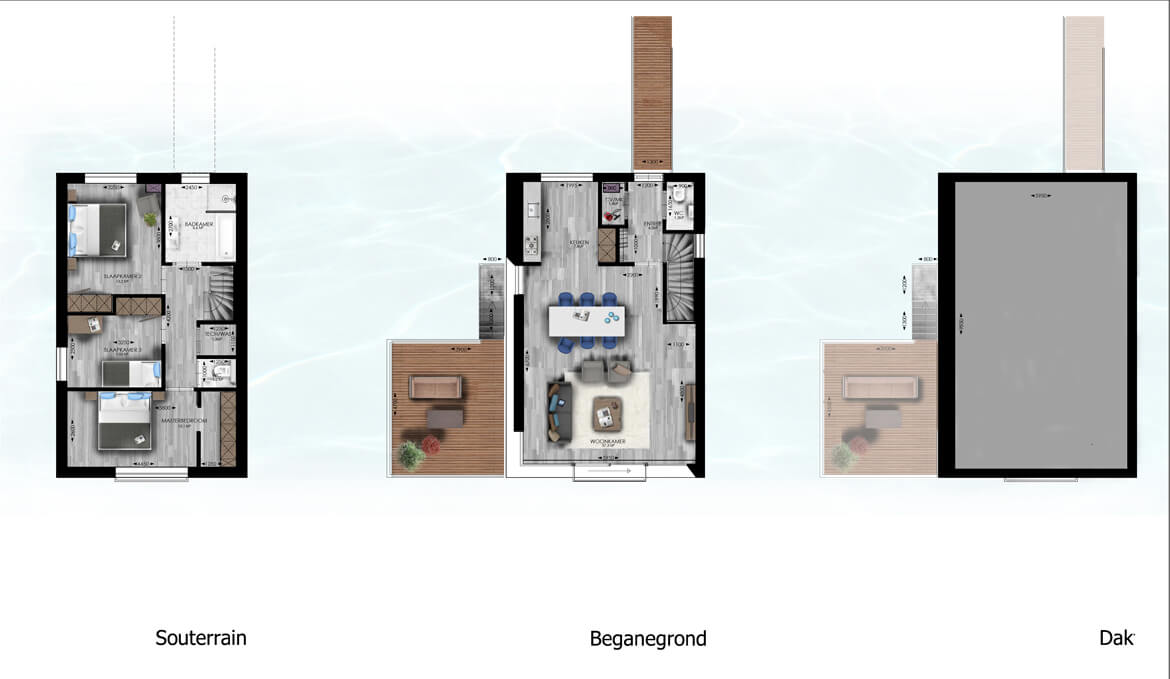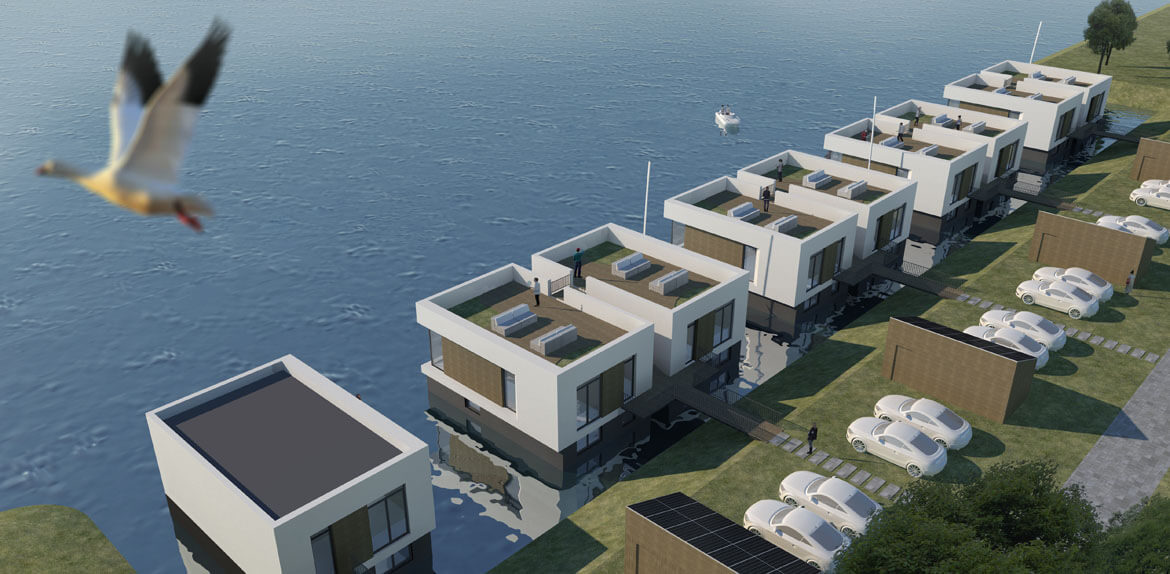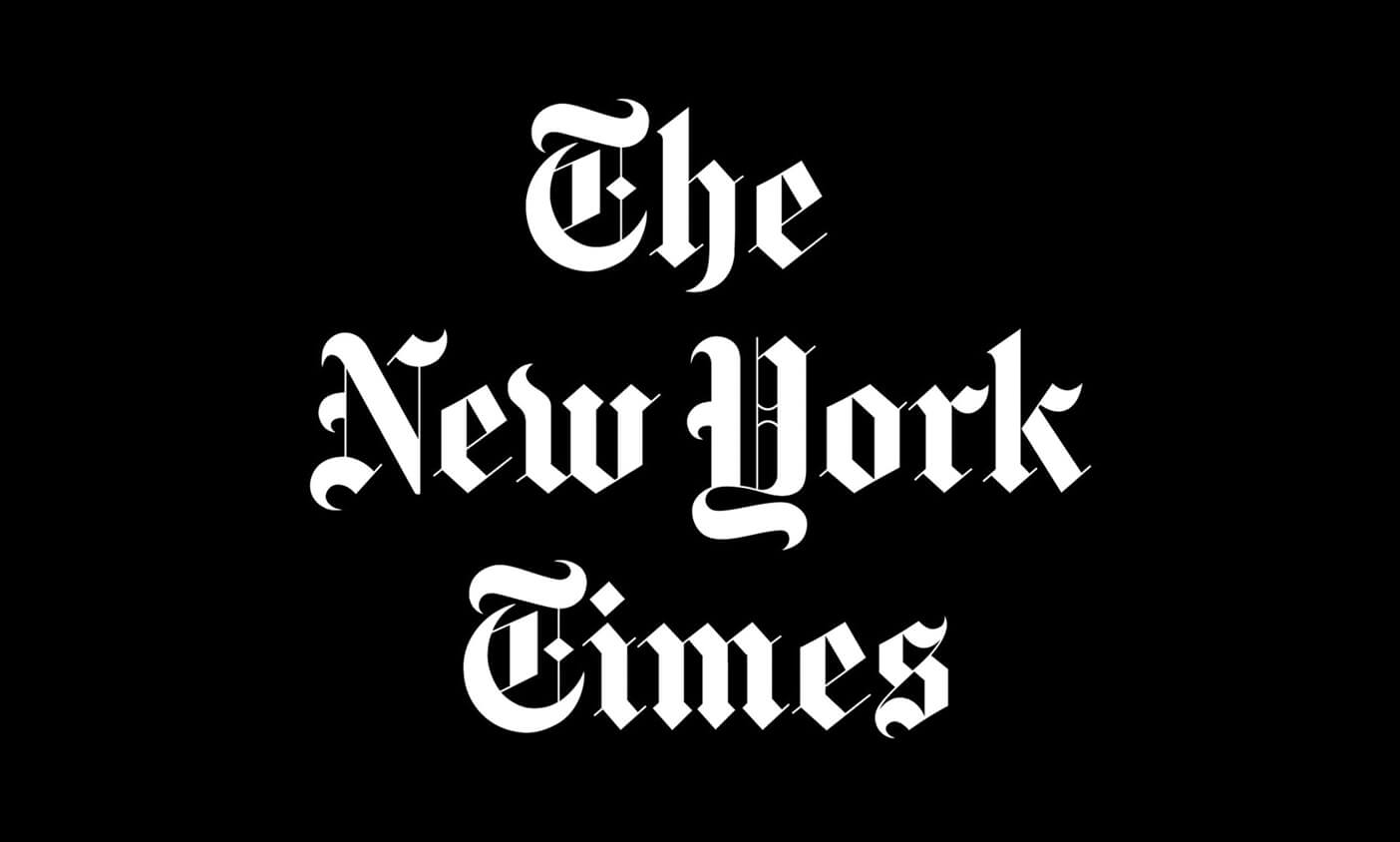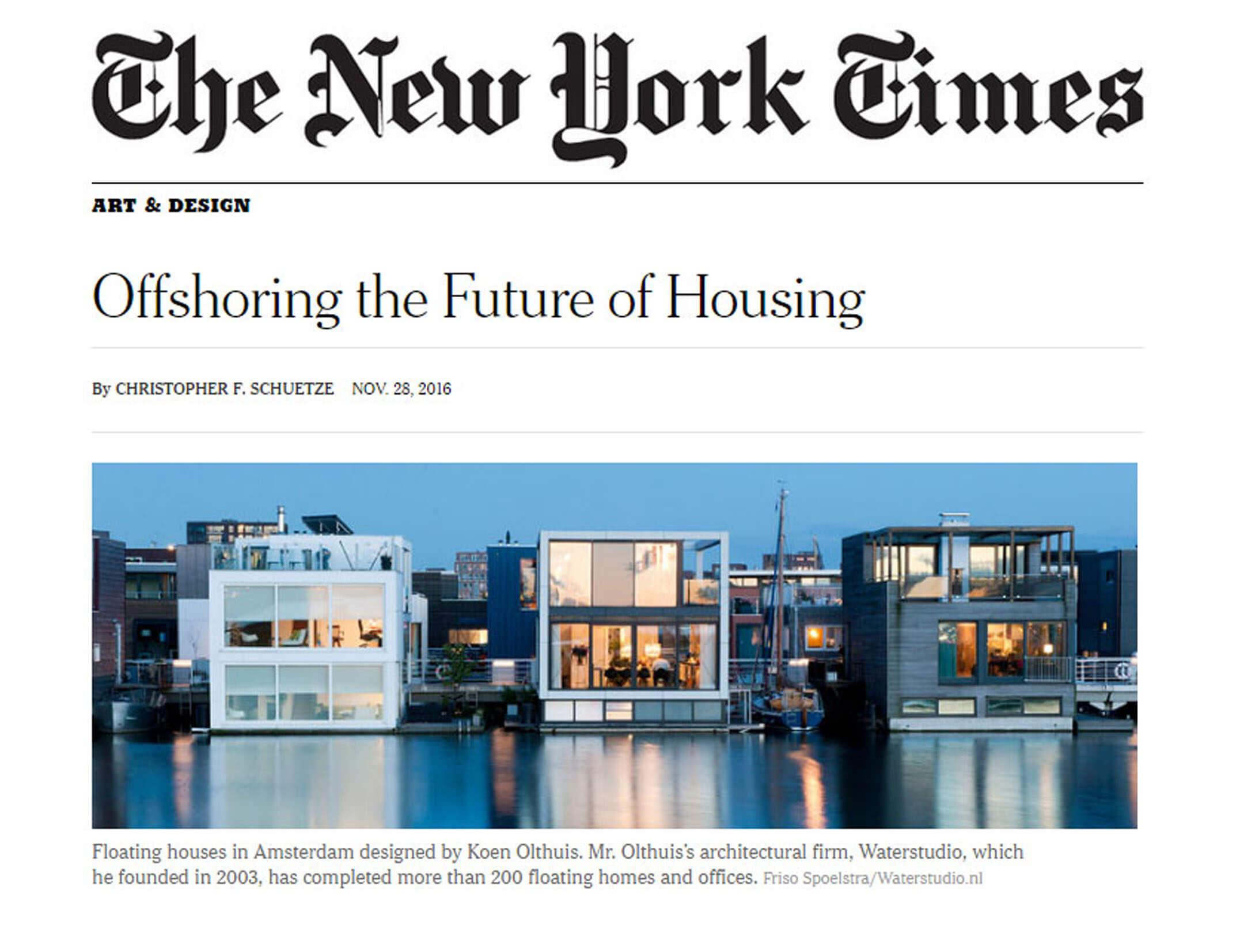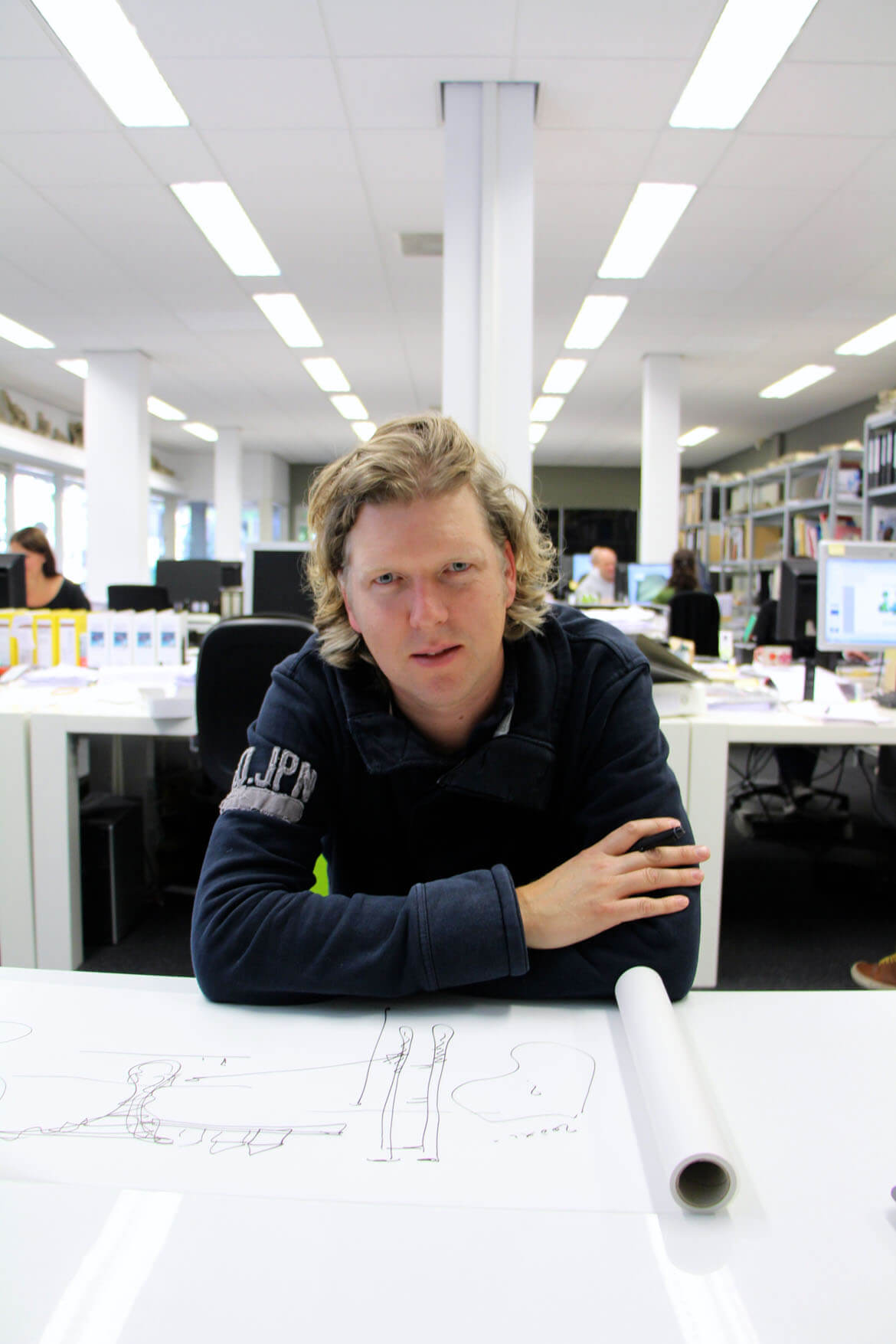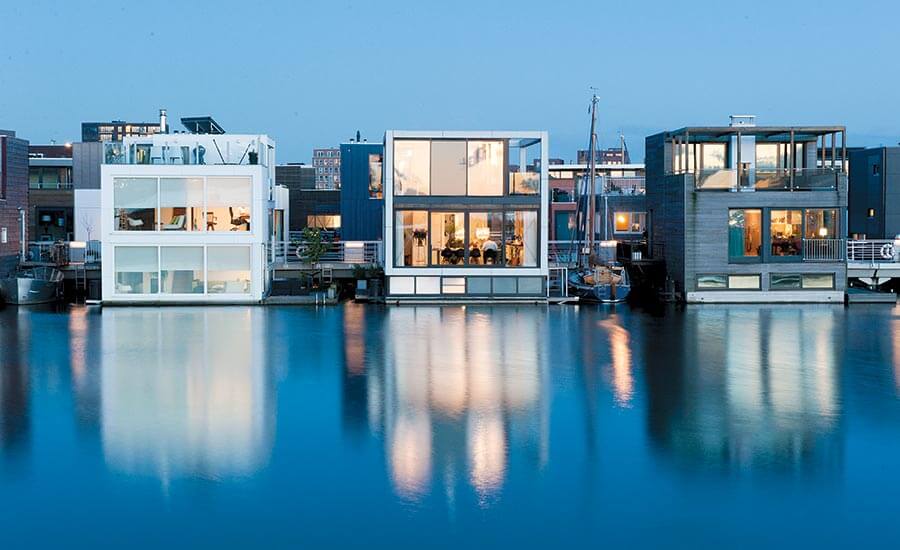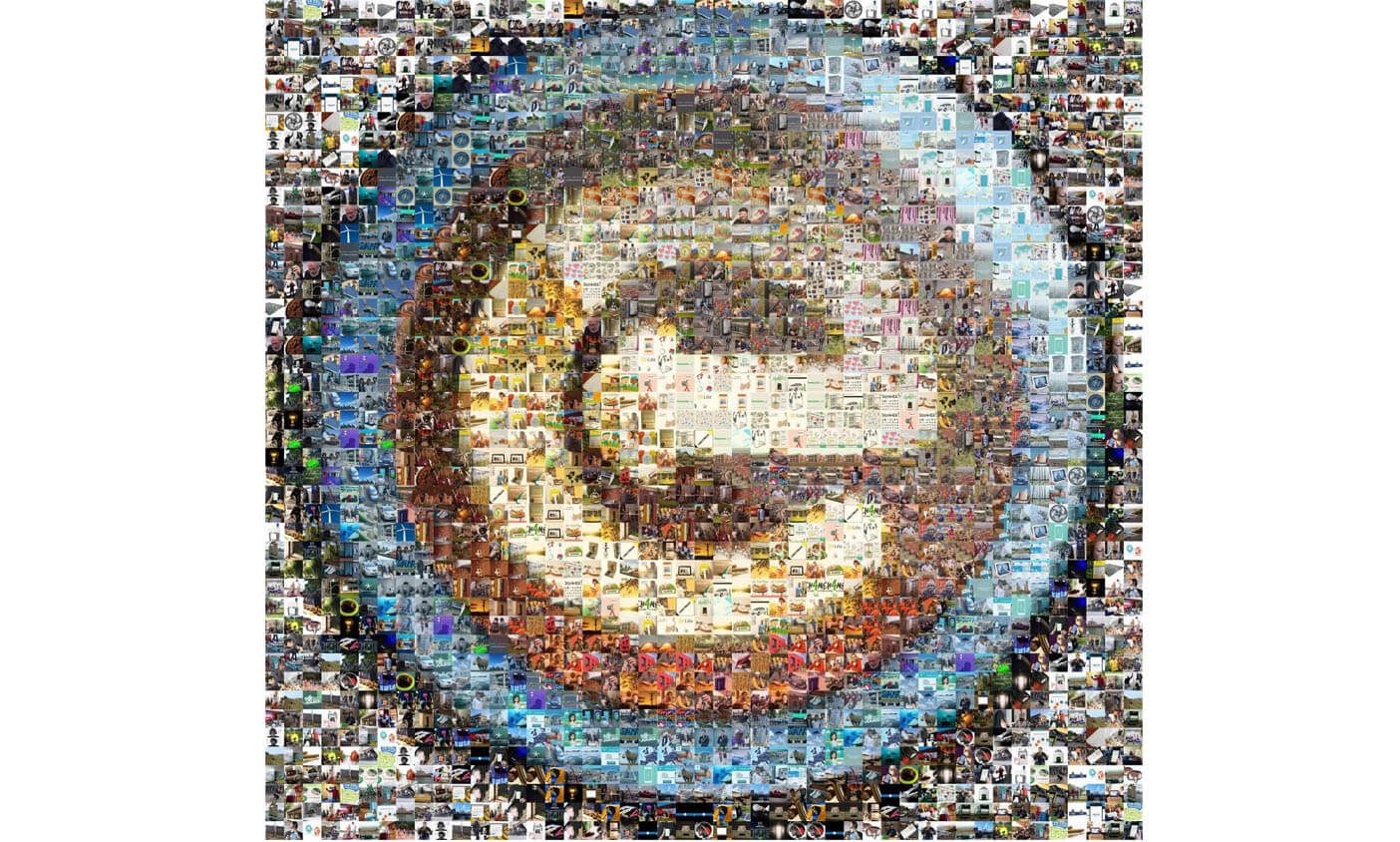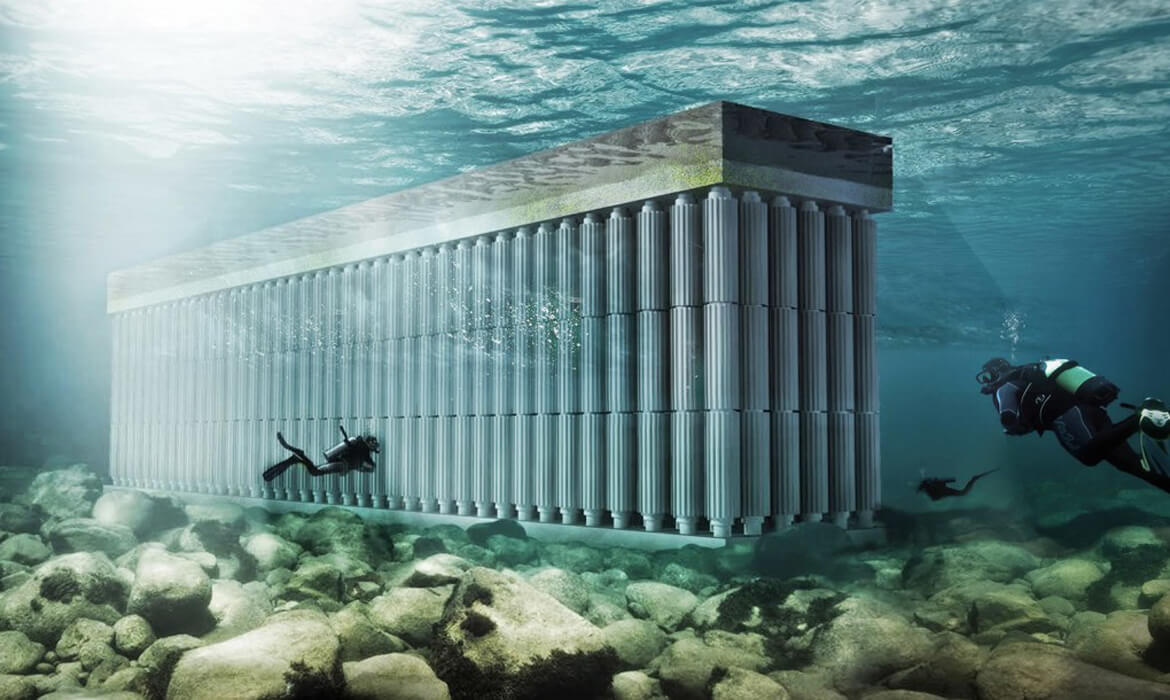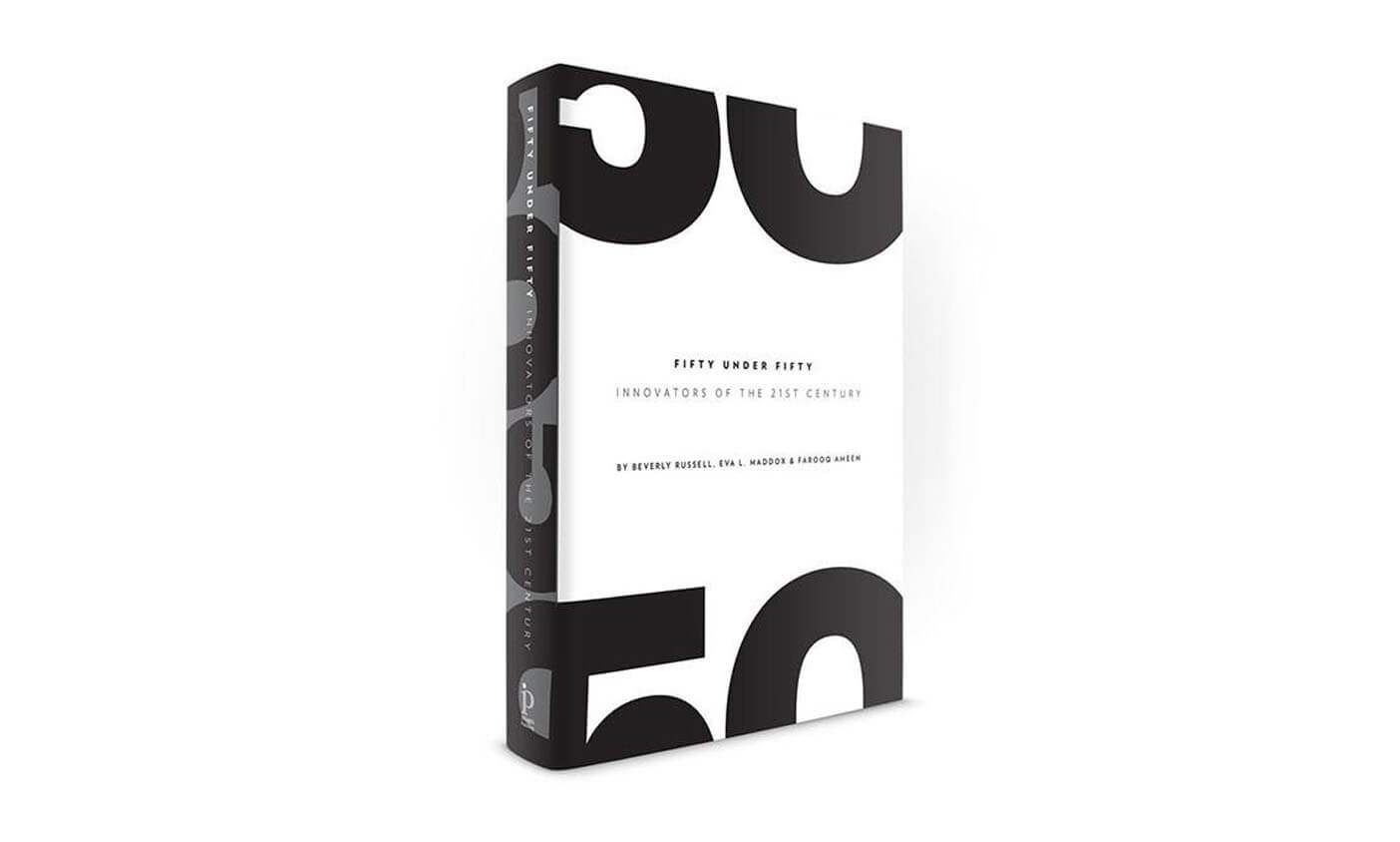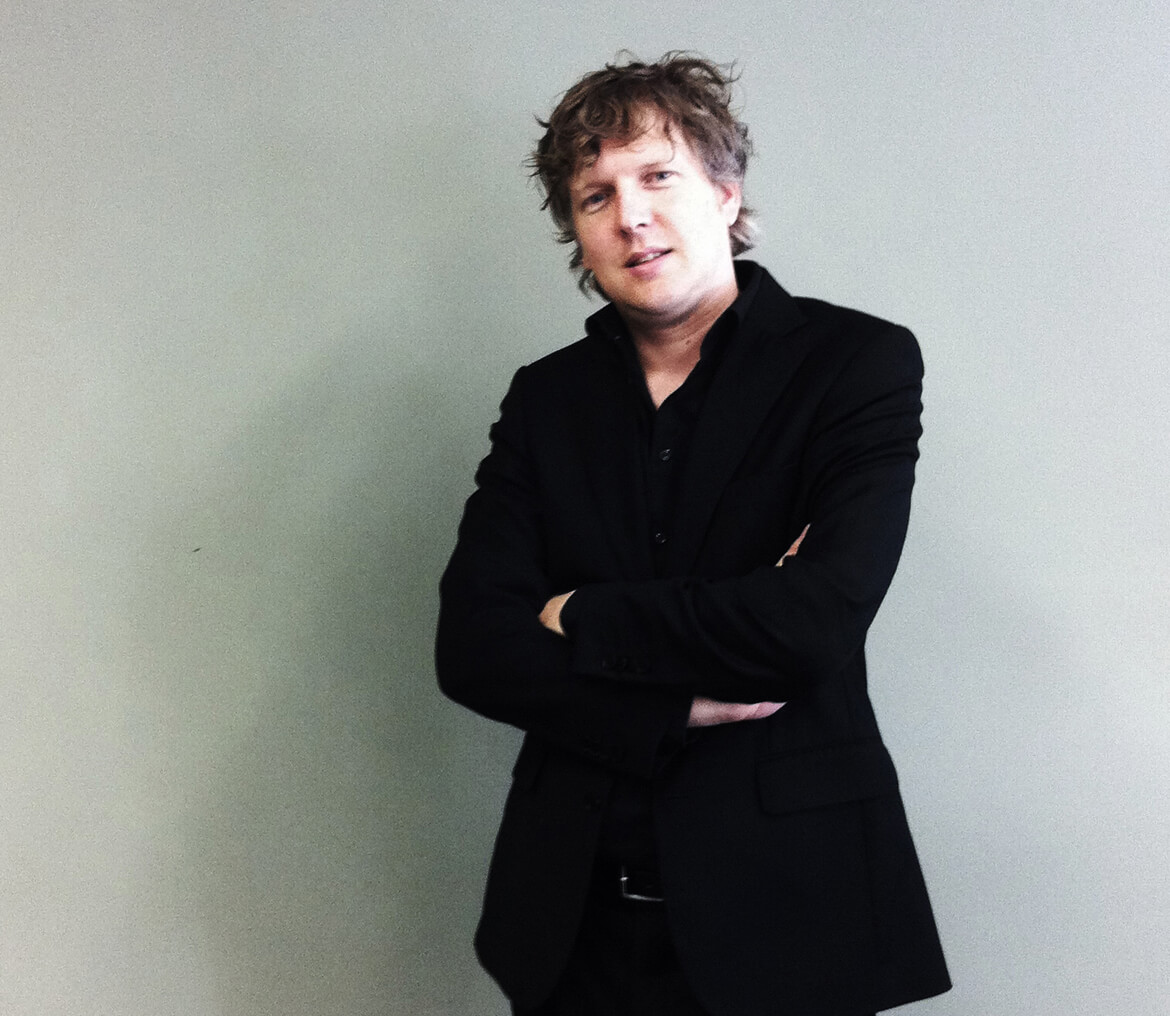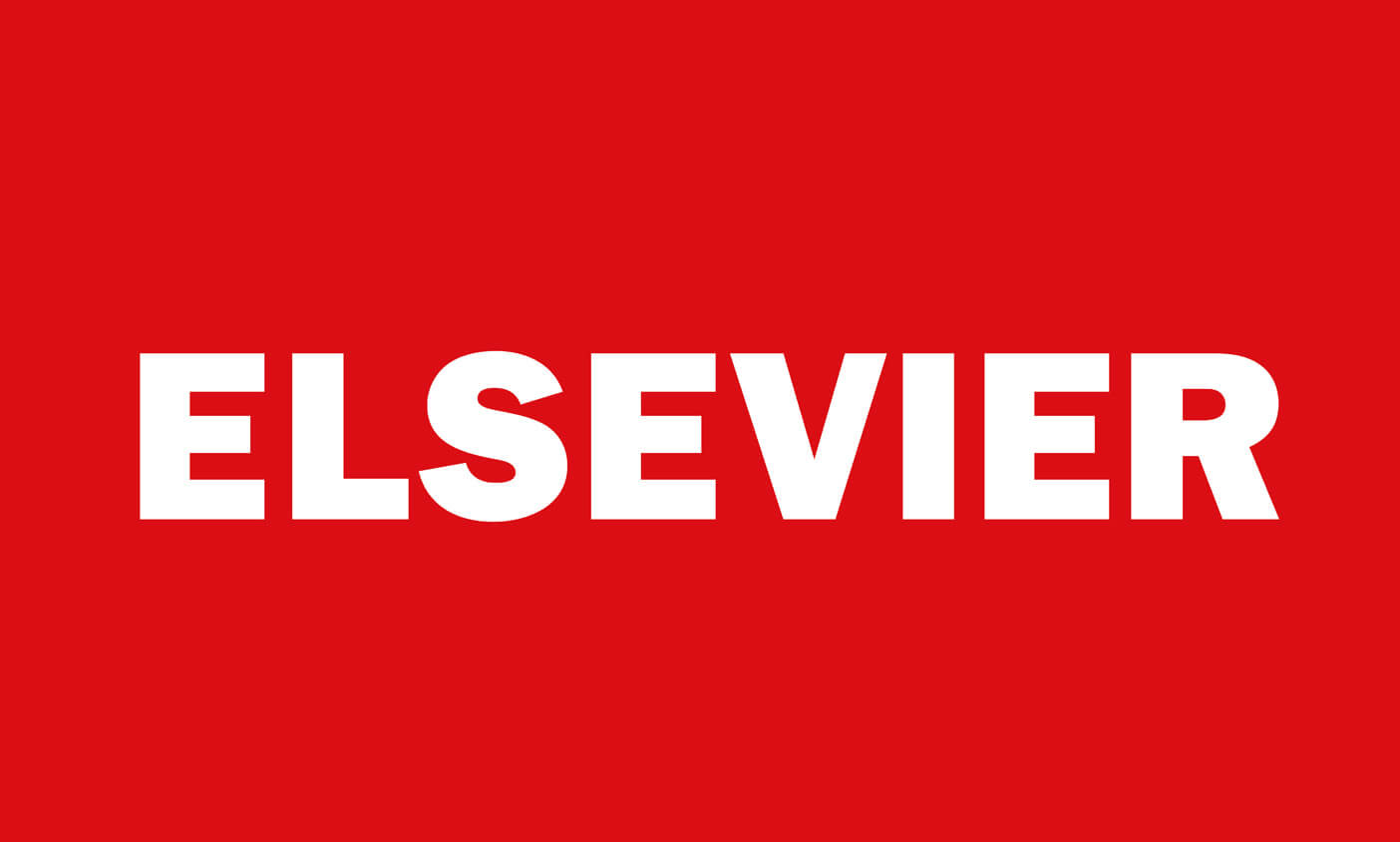Project Waterrocks Zeewolde (fase 1)
Project Waterrocks Zeewolde (fase 1)
Balance d’eau ontwikkelt in de Blauwe Diamant te Zeewolde luxe, drijvende woningen, door Waterstudio.NL onder architectuur ontworpen. U heeft rondom waterbeleving met vrij uitzicht over het water en weilanden. De woning heeft een eigen ligplaats met verbinding naar diverse recreatie vaarroutes. De ruime tuin met berging biedt tevens ruimte voor parkeren op eigen terrein.
Een unieke locatie voor drijvend wonen centraal gelegen in Nederland!
U wordt eigenaar van het perceel en de drijvende woning naar uw keuze.
In principe is dit min of meer hetzelfde als een landkavel, alleen de woning drijft en is afgemeerd aan meerpalen.
De woningen voor het project, Waterrocks de blauwe diamant, zijn ontworpen door Waterstudio.NL uit Rijswijk.
Het bureau, geleidt door Koen Olthuis, is al sinds 2002 gespecialiseerd in architectuur en stedenbouw op en aan het water. In 2007 Olthuis stond op nr 122 van de Time Magazine lijst met meest invloedrijke mensen in de wereld, door de wereldwijde interesse in zijn waterontwikkeling. Het Franse magazine Terra Eco koos hem als een van de 100 “groene” personen die de wereld gaan verbeteren in 2011. In 2015 hij is geselecteerd bij een internationale jury als een van de vijftig jonge vernieuwers van de 21ste eeuw in het boek “50Under50”. Bouwen op water is Olthuis levenswerk en hij is internationaal ook wel bekend als de “Floating Dutchman”.
U heeft nu de kans om in een echte Waterstudio woning te wonen!
Koen Olthuis: “De waterwoningen in de Blauwe Diamant hebben zijn voor ons heel bijzonder, wij zien de drijvende woning als een “normale” woning op een drijvende fundering. In dit project komt dit goed naar voren, een stevige ruime woning, een grote tuin en de sfeer van het leven op het water. Solid as a Waterrock!”
U heeft al een kavel met hierop een complete waterwoning type Waterrocks 1 voor € 429.500,- VON inclusief BTW.
Het Balance d’eau bouwconcept
De basis bestaat uit een robuuste drijvende betonnen kelderbak welke prefab wordt geproduceerd. De constructie van de opbouw is licht van gewicht, hoog geïsoleerd, stijf en sterk.
Kwaliteit
Een nieuwe woning is één van de belangrijkste beslissingen van uw leven. U moet kunnen vertrouwen op de kwaliteit. Dit is bij een drijvende woning niet anders dan bij een landwoning.
Mede omdat de Balance d’eau woningen uit prefab elementen op locatie worden geassembleerd is de bouwkwaliteit, het afwerkingsniveau en het wooncomfort van hoog niveau.
Genieten
Wonen op het water geeft een gevoel van vrijheid en natuurbelevening. Met het vrije uitzicht over het water en de mogelijkheid om vanuit uw eigen ligplaats met een bootje weg te kunnen varen ervaart u dit in project Waterrocks in de overtreffende trap. Elke dag voelt als een vakantiedag!
Optimaal wooncomfort
Met een speciaal ontwikkeld computerreken- en simulatiemodel wordt het ontwerp uitgebalanceerd en ligt het zwaartepunt zo laag dat de woning stabiel in het water ligt en ook bij harde wind nauwelijks beweegt. Zodoende kan het wooncomfort wedijveren met luxe landwoningen.
Duurzaam
Het bouwsysteem heeft een hoge isolatiewaarde. Hierdoor is het energieverbruik laag en voldoet het systeem aan de laatste EPC normen van het bouwbesluit.
Optioneel is zelfs een innovatieve warmtewisselaar mogelijk die de energie opgeslagen in het oppervlaktewater gebruikt om de woning te verwarmen, een innovatie op energiebesparing!
Interesse?
Neem bij interesse contact op met ZO makelaars – ZO.nl
Ook kunt u op afspraak de voorbeeldwoning te Delft bezoeken om de bouwkwaliteit, het wooncomfort, maar bovenal de meerwaarde van het vrije wonen op water te ervaren.
U kunt kiezen uit de volgende locaties:
Kavel 1, Ca. 383 M2: mogelijk in combinatie met de Waterrocks 1
Kavel 2, Ca. 307 M2: mogelijk in combinatie met de Waterrocks 1
Kavel 3, Ca. 267 M2: mogelijk in combinatie met de Waterrocks 1
Kavel 4, Ca. 267 M2: mogelijk in combinatie met de Waterrocks 1
Genoemde prijzen en gebruikers/woonoppervlakte zijn va prijzen en v.a. oppervlakten. De uiteindelijke prijs is mede afhankelijk van het door koper(s) gewenste meer- en of minderwerk.
Energie
Energielabel EPC 0,4
Verwarming Gasgestookte ketel
Warm water Gasgestookte ketel
Isolatie
hoog geïsoleerd, wanden Rc Ca. 6.5. Vloeren RC Ca. 5,3 en dak RC Ca. 6,5. HR++ beglazing.
Kadastrale gegevens
Zeewolde
Oppervlakte Ca. 267 – 383 m²
Eigendomssituatie Volle eigendom
Buitenruimte
Ligging Op het water en in woonwijk
Tuin met berging en 2 parkeerplaatsen, Dakterras
Dakterras Waterrocks 1 tm 3: Ca. 58 m²
Ligging tuin Geheel vrij gelegen
Parkeren
Soort garage Parkeerplaatsen op eigen terrein
Capaciteit 2 auto’s
Woningtypen
Waterrocks 1:
icm. Kavel 1 (383 M2): € 468.500,- VON incl. BTW
icm. Kavel 2 (307 M2): € 445.000,- VON incl. BTW
icm. Kavel 3 (267 M2): € 429.500,- VON incl. BTW
icm. Kavel 4 (267 M2): € 429.500,- VON incl. BTW
Luxe vrij liggende waterwoning met gestukadoorde gevels en deels duurzame houten gevelbekleding, onder architectuur ontworpen door Waterstudio.NL
Zeer royale woning met dakterras, weids zicht over het water en weilanden
Woning 6,5 meter breed, 10,4 meter lang.
Gebruiksoppervlakte Ca. 113.2 M2
4 kamers, zeer ruime woonkamer van ca. 37 m2 aan het water
Ruime keuken (keuken en apparatuur optioneel)
Grote glaspartijen voor maximaal uitzicht, grote schuifpui met Frans balkon
Riant dakterras van ca. 58 m2 met uitzicht over het water en de weilanden
Benedenverdieping voorzien van 3 ruime slaapkamers waarvan 1 met inloopkast
Ruime badkamer en 2 toiletruimtes (Sanitair en tegelwerk optioneel)
Tuin met berging voorzien van zonnepanelen
2 parkeerplaatsen op eigen terrein
Waterrocks 2 heeft aan de zijkant van de woning een deur met trap en plateau voor uw eigen ligplaats.
Waterrocks 3 heeft aan de achterzijde van de woning een balkon met trap en plateau naar uw eigen ligplaats.
Gebruiksoppervlakten
Wonen (= woonoppervlakte): 113.2 M2, dakterras 58 M2
Gebouw gebonden buitenruimte: Ruime aanloopsteiger, tuin met berging en 2 parkeerplaatsen
Perceeloppervlakte: variërend van 267 – 383 m²
Inhoud Waterrocks 1: Ca. 449 m3
Indeling
Aantal kamers: 4 kamers (3 slaapkamers, w.v. 1 met inloopkast)
Aantal badkamers 1 badkamer en 2 aparte toiletten
Badkamervoorzieningen: aansluitingen voor ligbad en douche
Aantal woonlagen 2 woonlagen
Planning
Projectfase 1: verkoop gestart Nu
Start verkoop Januari 2018
Start bouw september-oktober 2018
Verwachte oplevering 1e woning circa binnen 6 maanden na start bouw
Woningtypen
Van de 4 huizen in dit project zijn er nog 4 beschikbaar
Omgeving
Zeewolde ligt centraal in Nederland. Het centrum van Amsterdam of Utrecht ligt op nog geen 50 km afstand.
Zeewolde is een watersport paradijs met heerlijk zwemwater, idyllische vaarten en tochten om per boot of kano te verkennen. Vandaar dat de waterwoningen ruimte bieden voor een eigen ligplaats!
Aan de langgerekte Veluwerandmeren vind je een eindeloos lange kustlijn, Zeewolde heeft het grootste zoetwater ‘binnenstrand’ van Nederland! Nieuw is het eiland in de vorm van een tulp.Omgeving
In het centrum van Zeewolde kunt u heerlijk winkelen en even genieten op een gezellig terras waar je vele restaurants, cafés, terrassen, winkels en boetiekjes vindt. Overzichtelijk en modern ingericht en alles op loopafstand.
Zeewolde biedt vele kilometers gemarkeerde en ongemarkeerde wandelroutes, langs het water of door de bossen en uitgestrekte ruige natuurgebieden zoals De Stille Kern.
Het Horsterwold en Hulkesteinse Bos vormen een van de grootste aaneengesloten loofbossen van West-Europa, waar vele bijzondere dieren en planten voorkomen zoals bevers, zeearenden en wilde Konikpaarden
